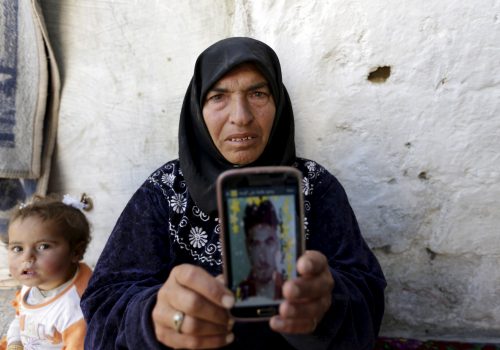Jordan is pushing for rapprochement with Syria. But is it to reinforce artificial stability in the region?
Despite accusing Jordan of being “part of the war on Syria” back in 2017, Syrian President Bashar al-Assad called King Abdullah II of Jordan on October 4 to “discuss ways to enhance cooperation” between the two countries. This call resulted in Jordan’s decision to re-establish ties with the Syrian regime after a decade of cold relations, where both embassies in respective countries stayed open but on lowkey operations. The normalization of ties with Syria is assumed to be a part of a broader regional stabilization plan that King Abdullah advocated for during his recent visit to Washington in July.
The plan proposed solutions for the crises in Syria, Lebanon, and Iraq through improved regional economic integration. Interestingly, Syria is also a cornerstone in these solutions as a corridor for gas and electricity—via Egypt and Jordan—to Lebanon, which suffers from a major energy crisis. Giving the Assad regime a pivotal role in so-called “diplomatic rehabilitation,” Abdullah called on the Joe Biden administration to adopt a Syria policy that pushes for regime “behavior change” instead of “regime change.” This plan will have various economic and political implications for Jordan and the rest of the Middle East and North Africa (MENA). Additionally, Jordan pushing for a Syria policy without tangible returns from the Assad regime on critical issues for the region—like guaranteed safe Syrian refugee return efforts and housing rights for returnees—sets an unhelpful precedent in MENA. Most importantly, this authoritarian cooperation will reinforce the pre-2011 Arab Spring authoritarian status quo.
The economics of diplomatic rehabilitation
Economically, Syria has always been considered as Jordan’s economic “lung,” where Amman and the Jordanian people—particularly in the north—economically breathe life into Syria. However, this time, reestablishing ties will also give a second breath to the Assad regime. First, the resumption of commercial flights between Damascus and Amman will provide Syria with a new channel not only to Jordan, but the rest of the world. While many western countries are still enforcing flight bans to Syria, Jordan will become a hub for international travel to Syria, thus, providing Damascus with renewed access to a regional airport.
Additionally, Jordan’s reopening to Syria gives Damascus a role in solving Lebanon’s crisis by providing the Assad regime with room to maneuver the Caesar Act sanctions by providing it access to Jordan and Lebanon. In fact, Jordanian officials have already started pushing for Caesar Act exemptions to facilitate fuel and gas to Lebanon to help solve its energy crisis. Similarly, the US reportedly provided Jordan with guarantees that it won’t be prone to sanctions under the Caesar Act due to its dealings with Syria, according to Jordanian reporter, Osama Al-Sharif.
In 2010, Jordanian exports to Syria prior to the civil war constituted around 3.65 percent of Jordan’s total exports. Due to the border closure, this figure declined to around 1.1 percent in 2019. These figures show a tiny portion of the lost opportunity for Jordan. Indeed, informal trade constituted a lifeline for northern cities—such as Ramtha, Irbid, and Mafraq—that used to import food, clothing, and other goods from Syria at much lower prices and made profits in Jordan, which the Jordanian state ignored for years.
According to Armenak Tokmajyan, a nonresident scholar at the Malcolm H. Kerr Carnegie Middle East Center, “The state allowed such trade because it supplemented local revenues, enhancing social stability. This saved the state from investing resources that would have been needed to create jobs. By undermining this understanding, the Syrian conflict provoked growing local discontent.” In other words, when the borders were open, the Jordanian government turned a blind eye to smugglers. However, when the war in Syria commenced, these people became unemployed and therefore a source of discontent. Moreover, Syria constitutes a main corridor for Jordanian exports to Europe and Lebanon, as it has land borders with Turkey and Lebanon and access to the Mediterranean Sea. These specifics demonstrate that the reopening of borders will provide Jordan with further social and economic stability.
In addition to recommencing trade, the normalization talks with Syria also entail negotiations on water between the two countries. These negotiations resulted in the reactivation of an agreement signed between Jordan and Syria in 1987, which allows Amman to annually receive two hundred million cubic meters of Al-Yarmook river water. This step is crucial for Jordan’s water security at a time when the country’s water problems are becoming even more challenging.
Therefore, Jordan’s efforts to reintroduce the Assad regime to the international community could be considered a tradeoff between Amman and Damascus. Jordan regains its regional role after four years of isolation under the Donald Trump administration while securing its national strategic interests. In exchange, the Assad regime regains its lost international legitimacy after a decade of civil war.
Who is benefiting?
Jordanian-Syrian relations can’t be well understood if looked at solely through the lens of bilateral ties. It’s important to understand the regional and international contexts as well. Regionally, their relationship is also affected by the conflict between Jordan’s allies in the Gulf and Iran.
However, it’s clear that a new regional dynamic—the US withdrawal from the Middle East—is pushing Jordan and other countries in the region to be more pragmatic in securing interests and promoting regional stability. For example, in July, King Abdullah warned that the current situation in Lebanon would lead to a collapse of the state, creating a fertile environment for terrorism coming from Lebanon. While in Washington, as part of his aforementioned regional stabilization plan, the king also called on the Biden administration and international community to help Lebanon in order to stabilize the region.
A deeper look into the push to help Lebanon with its energy crisis demonstrates that it is part of a proactive measure—that the US supports—to limit Iran’s ability to increase its influence in Lebanon via militant group Hezbollah. Although a popular proposal, many experts remain skeptical that the US can do so despite providing substantial financial support.
Moreover, King Abdullah’s “diplomatic rehabilitation” proposal suggests the potential for Assad to obtain better standing with Washington if he distances himself from Iran. These factors show that the current embrace of the Assad regime by some Arab countries in the region is also part of a power play in the Middle East, and not limited to protecting the Lebanese people from falling into further poverty.
Reinforcing the pre-Arab Spring status-quo
Jordan was not the only Arab country that reestablished its ties with the Syrian regime. The United Arab Emirates (UAE), Bahrain, and Oman have already reopened their embassies in Syria. Saudi Arabia apparently held talks about re-opening its embassy in May. Furthermore, the UAE was vocal in its disapproval of the Congressionally-passed Caesar Act. In March, Emirati Foreign Minister Abdullah Bin Zayed stated that, “there must be areas that open the door for collaboration with Syria, and keeping Caesar’s law as it is today makes it difficult.”
Within this context, the growing Arab support of the Assad regime without any preconditions sets a dangerous precedent. Moreover, it also risks welcoming back a regime that has become intertwined closely with Iran since the civil war began in 2011, with no clear plan to detangle one from the other, knowing the devastation Tehran has caused in Lebanon, Yemen, and Syria. It also indicates the beginning of a new era of authoritarian cooperation that attempts to reinforce the pre-Arab Spring atmosphere of artificial stability based on enhancing economic performance and maintaining the resilience of the current authoritarian structures.
Jordan’s legitimization of the Assad regime could be considered a regression for human rights in the region, which also ignores the atrocities committed during the Syrian civil war. Jordan’s new approach toward Assad also applies to other authoritarian Arab regimes and gives them assurances that they can provide artificial stability in exchange for minimal human rights for their people.
Overall, King Abdullah is seeking to play a new role in the region, providing life-saving gas and fuel to the citizens of Lebanon and Syria while also ensuring economic opportunity for Jordan after years of economic hardship. It is imperative, however, that this deal be paired with other issues of crucial importance to the region, particularly the Syrian people, for it to be deemed a comprehensive approach that limits the damage caused by the Assad regime over the last decade.
Laith Alajlouni is a Jordanian political economist and social policy researcher specializing in the political economy of development in the Middle East region. Follow him on Twitter: @LaithAlajlouni.
Image: Supporters of Jordan's King Abdullah II gather at the White House ahead of his meeting with U.S. President Joe Biden in Washington, U.S. July 19, 2021. REUTERS/Jonathan Ernst


